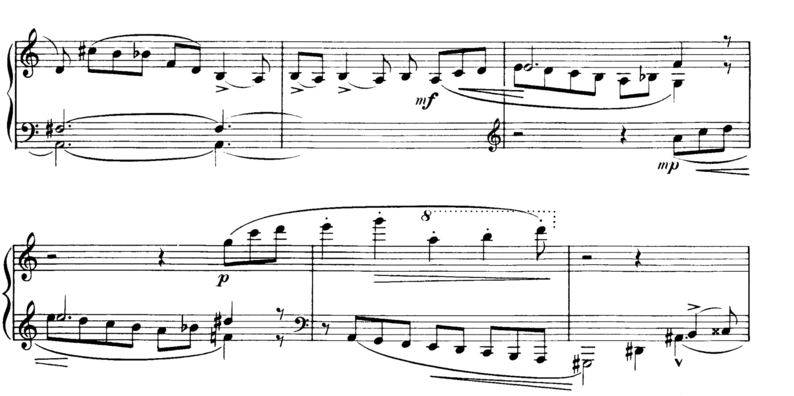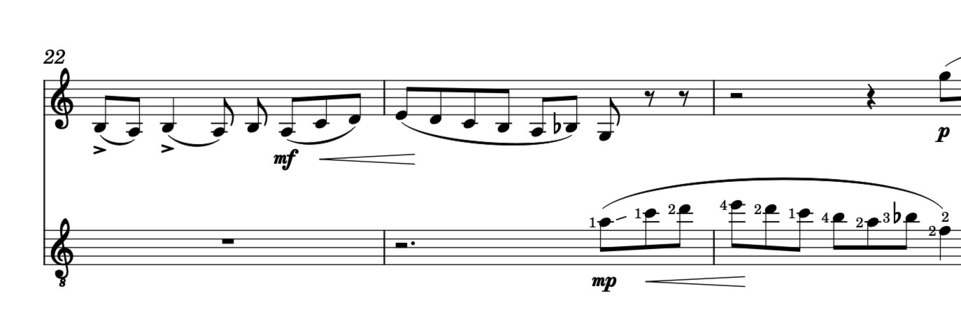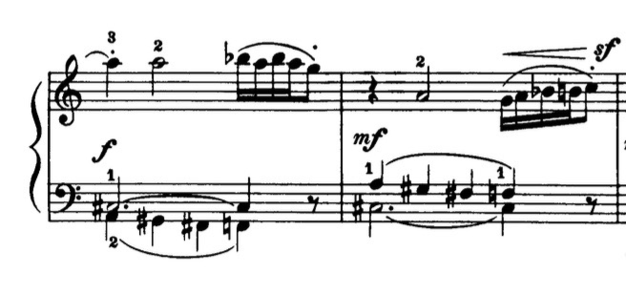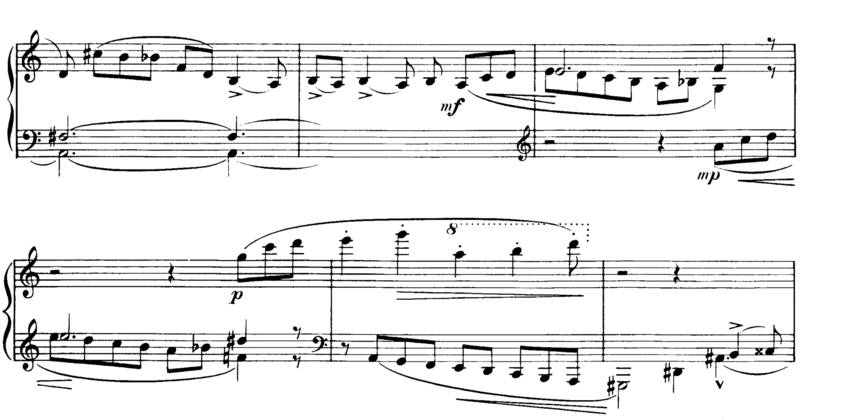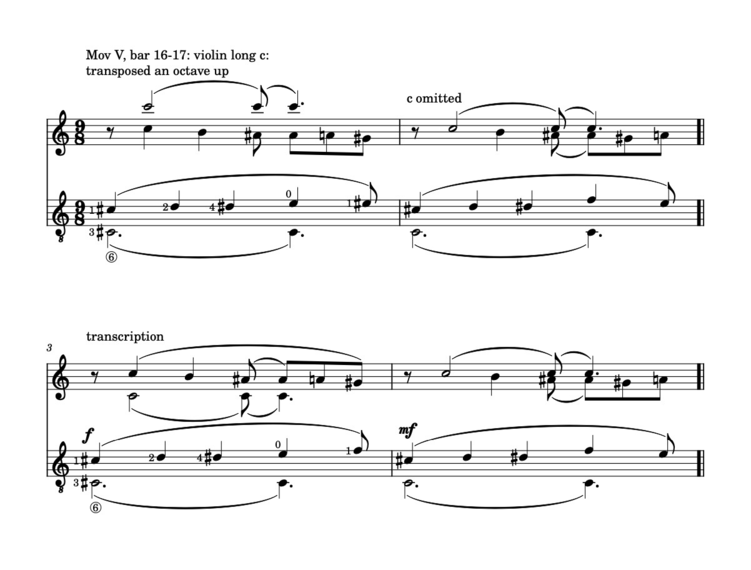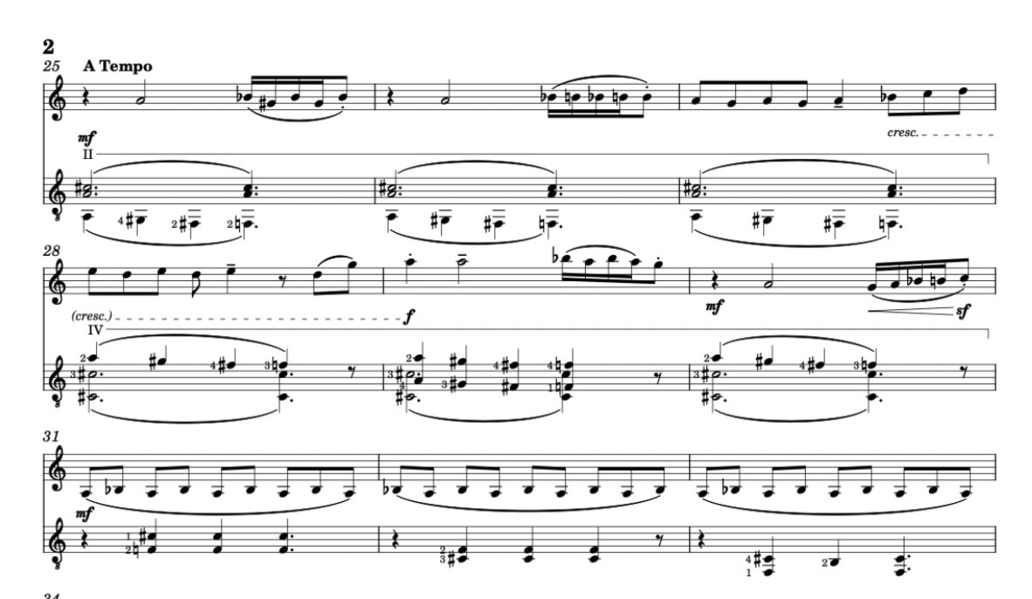IX Dynamics
Movement V, bar 16-17
It is not possible to play the upper stave of the piano part on the violin, because of the two identical notes in the same octave at the same time. So the options are either to omit one of the two c's or to transpose one of them.
Transposing an octave upwards makes the sound of the long c very sharp and present. It also not possible to keep to c sounding for the entire bar. On the piano, because of the nature of the plucked instrument, the sound of the c diminishes as soon as it is played. Because the violin is a stringed instrument and this note is sustained by the bow, the sound remains as loud as the other notes played in the same bow. By transposing the c down an octave, it sounds less sharp and strong because the quarter notes are now the highest.
If the c is omitted and the other c is accentuated, it creates an impression of two c's. Also the sound of the c is still there while the other notes are played, because it is an octave lower in the guitar part. So both options are possible. In the original, bar 16 has the dynamic forte and bar 17 has the dynamic mezzo forte. In bar 17, the violin part is also an octave lower than in bar 16. Because of this dynamic, I chose to write the option with the two c's in bar 16. This is louder than omitting the c. Thus, just as in the original the difference in dynamics is also present in the transcription by means of the two options of double c.
V Bowings/slurs
There is a difference between musical slurs and bowings for string instruments, even though they are notated in a similar way. The slurs in the original score are musical slurs. They indicate the musical phrases in the music. They also indicate the legato articulation for the piano. The violin bowings mark the specific movements of the violin bow. All the notes under the marked legato slur are played in one bow on the violin. These two different slurs should therefore not be confused with each other. The violinist must adapt his/her bowings to the slurs but must not interpret them as literal violin bowings. Sometimes, however, the original slurs can perfectly serve as violin bowings, but usually this is not case. Below are two examples. I chose to transcribe the original slurs, so the violinist is still free to choose his/her violin bows, but in an informed manner.
Movement I: 22-23
Bartók writes one bow from the third beat of measure 22 to the last note of measure 23. As there is a crescendo and a mezzoforte, it is very difficult and unnatural for the violinist to produce this dynamic and so many notes in one bow. The phrase also needs to have a forward direction, because the guitar part takes over the exact same phrase right after the violin. Therefore, it is more effective to change the bow where the crescendo stops, so there is a new bow for the loudest point.
Movement I, bars 4-18; 53-60
The addition of rasguado to some chords increases the volume of the guitar part. However, the purpose is not to add some sort of Spanish influence to the piece. That is why I carefully chose the loudest passages to use this technique. The rasguado has to be very fast, so it is almost like a block chord, but stronger.
Movement V, bar 25-30
The passage begins mezzo forte. From bar 27 to bar 29 there is a crescendo. Bar 29 is forte and bar 30 is mezzo forte. In bar 28, when the crescendo begins, Bartók writes the long c in the lower part an octave lower, so that the voices are swapped and the long c becomes the bass. On the forte, Bartók also writes the second voice (4 quarter notes) an octave lower, so that both voices are reversed again, and on the mezzo forte in bar 30, he writes everything back as it was in bar 28. Since the upper staff, played by the violin, has a melody that develops throughout the passage and has the same dynamics, it is important that this melody is supported by the guitar. So I decided to play the bass an octave lower to give the violin more support by bass notes. However, I keep the long c in the same octave and I double the a, so that the triad still has enough resonance and projection. In that way both voices are one octave apart. It is no longer possible to transpose the bass an octave lower in bar 29 as in the original. Since the violin has crescendo and forte, it is more effective to transpose the bass up two octaves in the crescendo (bar 28), so that it sounds more present. The long C then becomes the bass and is transposed down two octaves, so that there is still a resonant bass to carry the violin melody. In the forte in bar 29, I choose to double the second voice an octave lower, so that it sounds even louder. In the mezzo forte in the next bar, I remove this doubling. This is an example of how dynamics are supported in the transcription in a different, more idiomatic way than in the original.
Movement I, bar 39-42
In these three bars, I decided to actually keep the original slur, even though there are quite a lot of notes in one bow and it is a forte passage. The reason for this is that this passage is the result of an accelerando of six bars, which finally arrives at the tempo primo. In my opinion, Bartók writes very clearly one bow per measure, so that the whole measure is always directed to the next one, without accentuating any note except the first one of the next measure. In this fast tempo, it is possible to play so many notes in one bow, and it enhances the effect of direction inside the bow, as well as a legato sound and fluidity.
VII Articulation
Is the choice of articulation part of the transcription process, or is it the performer's responsibility and choice? And to what extent? Every note can be played with a different articulation. So every musician plays the same work with slightly different or even many different articulations. There is a huge range of different articulations per instrument, and within those different articulations there are so many small nuances. In Bartók's original score, there are a lot of specific articulations written into the score. They give a direction within the palette of articulations to choose from. Of course, these articulations are written with the piano in mind and sound different on guitar and violin. A staccato on the violin will never sound as short and percussive as a staccato on the piano, unless it is played pizzicato. The use of the bow also allows this staccato to sound in different ways, whereas the range of choices for staccato on the piano is more limited. In a lesson with my guitar teacher Pavel Steidl, he advised me to add many more guitaristic articulations, such as Bartók pizzicato's, all kinds of rasguados, slurs, vibrato and even percussion on the guitar. He referred to the folkloristic aspect of this music and the articulations and effects used by modern folk guitarists. He is convinced that adding some of these articulation techniques in certain places would make the transcription more interesting and more varied. In this way he would actually add a form of authenticity to the transcription, namely that of our present time and environment. This idea is very interesting, but the question is how far I want to go with it. Adding too much of these folk acoustic guitar articulations would take the transcription too far from Bartók's style and idea, which was to incorporate the Bulgarian rhythm into his classical contemporary style. I still want to be closer to the classical style than to the folk style. However, it is true that these articulations make the transcription more authentic to the chosen instrument, the guitar. That is why it is important to find a balance by carefully choosing the places where to include these kinds of ‘folkloristic’ articulations. I will certainly not write an articulation for every note, so that the performer still has room to invent his own articulations and thus make his own interpretation. Below are some examples of articulations that are not possible on the piano but fit the musical idea of the piece.
Movement I, bars 21, 28, 31
Vibrato and glissando are two types of articulation that cannot be applied to the piano. However, it is useful to add these two articulations to the guitar part. Vibrato makes the sound longer. Glissando makes the sound more legato. Lengthening the sound and making it more legato is what the piano does with the pedal. The violin uses vibrato and glissando much more than the guitar in general. Adding them to the guitar part brings the sound closer to that of the violin. In that way the sounds of both instruments are mixing better together ánd the effect of the piano pedal is transferred to both instruments.
X Reflection
As I wrote in the second chapter, it is necessary to know the instruments the transcriber is writing for, inside out. I assumed that after 13 years of experience as a classical guitarist, I would have mastered this. However, it has not only been more difficult than expected to assess whether certain passages are playable and work on the guitar, but also whether they sound well together with the violin part. I tended, although I didn't set that as a goal first, to stay as faithful as possible to the piano part, or at least adopt the literal piano part first where possible. As a result, it took a long time to master my part written this way, which does not sound natural on the guitar. In rehearsals, this often caused a problem concerning the balance between the two instruments. Since many notes did not have full resonance because of the difficulty of the part, the guitar did not sound loud enough. Then I tended to double the notes and use more open strings to make the guitar part thicker and louder. Later, by letting the seemingly non-guitaristic and complex piano part grow on the guitar by thinking about better fingerings, rehearsing more and understanding the music better, it turned out to be less necessary to double notes after all. Since we chose this work because it has just so many idiomatic characteristics for both our instruments, it was well worth sticking as closely as possible to the original score first. This shows that after transcribing, enough time should be set aside to really experiment with fingerings, articulations, balance, ... both individually and in rehearsals.
I further noted that my two preconceived goals of being authentic to the idiomatic characteristics of our instruments and being authentic to the style of the work can effectively complement each other. Where Bartók wants to highlight the Bulgarian rhythm, it works particularly well to do so by having both our instruments play pizzicato. Where Bartók suddenly adds a lyrical passage, it comes out stronger when the violin plays with vibrato and various bowings, ... Within the addition of idiomatic articulations, however, it remains a search for a balance between being faithful to the yet predominantly classical style of the original work and contemporary folk style.
Finally, I noticed that the usual stumbling blocks for violin-guitar duos such as balance, difference in touch, different dynamic ranges, can be very much remedied in the transcription process. By carefully and nuanced handling of register, orchestration and articulation, the instruments automatically come closer together, so to speak.
VI Omitting notes
Movement I, bar 23-24
In the third section, next to the main melody, there is a second voice consisting of long note values that alternates between the two instruments. In the original version, this second voice alternates with the main melody between both hands on the piano. In fact, it is not possible to add this second voice to the violin part, as the double stops are not possible. Adding the second voice entirely to the guitar part would disturb the alternating melodies. Since the main melody is the most important, I decided to omit the second voice.
Movement II, bar 1-4
Pizzicato is a technique often used in as well violin as guitar repertoire. It creates on both instruments a percussive sound. It is perhaps the only articulation that is as resemblant on both instruments. As earlier mentioned, the core of this movement is the rhythmic interplay between the voices alternating and forming together one voice. The first three bars where the rhythm is presented are written in the piano score as one voice. With the pedal marking, there is an extra resonance strengthening the overall part. This could be emulated in the transcription by attributing the lower part to the guitar and letting the double stops ring through while the upper part is played by the violin. The upper part should then be soft, so the resonance of the double-stops on the guitar is not overpowered by the violin. That is why I chose pizzicato’s for the violin part. They have a very dry and percussive sound so they won’t disturb the resonant guitar part.
However, I decided to change the articulation and instead of the extra resonance and legato sound of the pedal marking, I chose a staccato articulation and dry sound. In that way the sound of the guitar and violin is more similar and the rhythmic interplay between our two instruments is clearer. The double stops in the violin part are performed staccato, and the guitar part has pizzicato’s. These give a more present and percussive sound. Later on, Pavel Steidl, my main instrument teacher recommended me a special technique consisting of tapping with the left hand on the finger board. The sound is similar to a pizzicato sound, but it doesn't have the demped sound the pizzicato has. It is more open and clear. The change of articulation from a legato and resonant sound to a percussive and sharp sound fits my goal of prioritizing the idioms of our instrumentation, instead of prioritizing the idioms of the piano.





